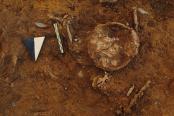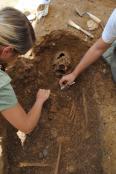CAMPAGNA 2014 |
1° SETTIMANA |
2° SETTIMANA |
3° SETTIMANA |
4° SETTIMANA |
5° SETTIMANA |
6° SETTIMANA |
7° SETTIMANA |
8° SETTIMANA |
23 LUGLIO 2014 
Resoconto della giornata di scavo
Area 2000
Terminata la rimozione di USk 2475 nel Settore B di epoca medievale. Le ossa si presentano fortemente annerite e lo scheletro è tagliato ad Ovest dalla fossa del colera che prosegue al di sotto della chiesa, visibile solo in sezione.
Nell’allargamento è stata chiarita la funzione del taglio US -2462, allungato e molto irregolare, collocato nella porzione centro meridionale; si tratta di un ossario all’interno del quale sono stati rinvenuti numerosi frammenti di vertebre, cranio e coste ed almeno due mandibole, un omero, un radio e tre femori. Uno di questi femori si presenta molto ruotato; sebbene non sembri patologico l‘individuo in vita doveva avere problemi di deambulazione importanti.
Subito a Nord è stata individuata un’ulteriore fossa sepolcrale (US -2480), orientata NS e che intercetta superficialmente il riempimento dell’altra sepoltura con andamento opposto US-2459. All’interno è stato parzialmente esposto USk 2481 di cui non si conservano né il cranio né gli arti inferiori, che si presenta orientato NS e con l’arto superiore sinistro flesso sul bacino e il destro leggermente flesso sul pube. E’ interessante notare la totale fusione di alcune vertebre toraciche e lombari che farebbero pensare ad una dish patologica; caratteristiche infatti della malattia sono la calcificazione e l’ossificazione dei legamenti anterolaterali della colonna vertebrale.
We started the day by cleaning 2000 B, part of 1000 B, and the western expansion of 2000 A. After the expansion was cleaned, a cut in the center of it was explored, that was oriented west-east. While it was being excavated, it was discovered that another grave cut that one, that was oriented north-south. On this north-south skeleton, a medallion was found. An ossuary that was previously discovered was fully excavated. Within this ossuary, a right femur had an unusual morphology, by being twisted, most likely caused a limp during life. In addition, the medieval grave that was cut by the church and a cholera victim, was finished being excavated. Only parts of the lower limbs, pelvis, vertebrae, and left arm were recovered. Interestingly, part of the pelvis was burnt, most likely due to lightening rods.
Area 3000
Nel Settore A si è proceduto con la rimozione dell’individuo USK 3449, orientato N-S e deposto in decubito dorsale all’interno della cassa litica US 3407; al di sotto dell’inumato, parzialmente ridotto, è stato individuato il fondo della tomba, caratterizzato da uno strato a matrice argillosa, di colore giallastro e di consistenza compatta. Nella porzione centro-settentrionale del Settore B la rimozione dell’individuo USK 3438, sepolto supino a sud del perimetrale settentrionale USM 3073, ha messo in evidenza un altro inumato (USK 3432) anch’esso orientato N-S e deposto in decubito dorsale. Si tratta di una donna adulta la cui porzione superiore del corpo è stata intercettata ed asportata dalla canaletta ottocentesca US – 3257; il cranio infatti è assente, così come la parte prossimale di entrambi gli omeri e del torace. Gli arti superiori sono flessi ed incrociati sull’addome, mentre quelli inferiori sono distesi, con i piedi appoggiati alla parete meridionale della fossa. Fra le ginocchia è stata rinvenuta una medaglietta devozionale in bronzo e, vicino ad essa, due vaghi da rosario. Più ad ovest è stato messo in luce uno scheletro mal preservato, orientato W-E immediatamente a sud di USM 3073; a sud della mandibola è stato rinvenuto un oggetto di forma allungata in lega di rame, la cui funzione non è ancora del tutto chiara; si tratta forse di una specie di fermaglio o di spilla utilizzato per chiudere una veste, oppure, più verosimilmente, un elemento in metallo che doveva caratterizzare parte della cassa lignea in cui era stato deposto il defunto. Nella porzione centro-orientale del settore è iniziata la messa in luce dello scheletro in connessione anatomica USK 3449, orientato W-E e deposto in decubito dorsale all’interno di una cassa lignea, in seguito collocata nella fossa sepolcrale US – 3447.
Today in Area 3000, the skeleton in the NW section and the lithic coffin were removed for analysis. Three new skeletons were exposed along the northern wall of Sector B. The skeleton in the north was oriented west-east, and only composed of a skull and thorax with some upper limbs. This skeleton was poorly preserved, and included a shroud pin and hair pin as grave goods. It also had two large nails and smaller nails around its cranium. The other skeleton that was exposed was cut by a trench excavated in a previous field season. This skeleton was oriented north to south, and had two beads and a medallion as part of the grave goods. This skeleton was fully excavated and documented, and will be removed from the grave tomorrow. The final skeleton was located in the easternmost part of Sector B. This grave included slag and charcoal, nails, and a pin near the left arm. This skeleton was also very well preserved and was a very large person based on the size of the femoral heads. Tomorrow, the skeleton will be completely exposed and documented.
Area 4000
Nel settore orientale dell’area è proseguita la messa in luce della fossa US -4183, orientata nord-sud, la quale sembra assumere sempre di più la funzione di sepoltura con riduzione, dato che, ai piedi della sepoltura primaria presente in essa (USk 4209), l’accumulo di ossa lunghe e elementi craniali (US 4210) si sta rivelando sempre più consistente. Sul limite settentrionale dell’area, a ridosso della sezione nord, è stato messo in luce il taglio US -4212, orientato est-ovest e parallelo ad altre sepolture precedentemente indagate. L’ipotesi che esso includa un ulteriore inumato è molto forte, anche se devono essere ancora definiti i rapporti con altre fosse adiacenti che lo intercettano lungo il limite meridionale. Nell’angolo nord occidentale infine, è proseguita l’indagine sulla sepoltura USk 4821, individuo maschile posto supino e orientato nord-sud, parallelamente al muro interno del chiostro abbaziale. Tale sepoltura sta rivelando la porzione superiore dello scheletro, incluso il cranio recante un omero interposto fra mascella e mandibola, probabile fenomeno tafonomico post-deposizionale.
In Area 4,000 we continued the excavation of the cut US 4183 and its fill US 4178. We found several more long bones, as well as a mostly intact cranium and several large cranial fragments. We cleaned the area and photographed it in entirety. We concluded that the cranium with the articulated mandible in the northern edge of the fill is a primary burial(USK 4209) and the other bones are the secondary burials of at least 3 individuals (US 4210). After the rainwater in US 4213 dried we were able to once again establish the cuts. We uncovered 3 distinct cuts over lapping each other near the northern wall and 2 containing 2 cranial fragments in each. We believe these cuts are burials or partial burials all made at different times. We hope tomorrow to expose more of the bones in the fill. We also continued the excavation of the burial USK 4821, which was half excavated last year.
Area 5000
Oggi si è proceduto con l'esplorazione dei numerosi tagli che intercettano l'area di scavo nella porzione orientale. Nello specifico, è stata messa in evidenza una fossa ellittica (US -5109), dal riempimento scuro caratterizzato dalla presenza di frammenti litici e carboncini. Altri due tagli, inoltre, sono stati individuati a sud: entrambi circolari e poco profondi. Infine è stata effettuata una pulizia generale necessaria per la documentazione fotografica dell'intera area.
Today in area 5000, we began the day with cleaning and removing the top layer of soil that was covered with debris due to the rain. Afterwards, we completed the excavation of the holes found across the entire area. We proceeded to clean the entire surface area in order to prepare for a picture. There are currently several working hypotheses as to what the relationship of these holes and feature mean to the entirety of area 5,000. Further analysis of area 5,000 is needed to understand the sections significance and relationship to the to the entire site of Badia Pozzeveri.














